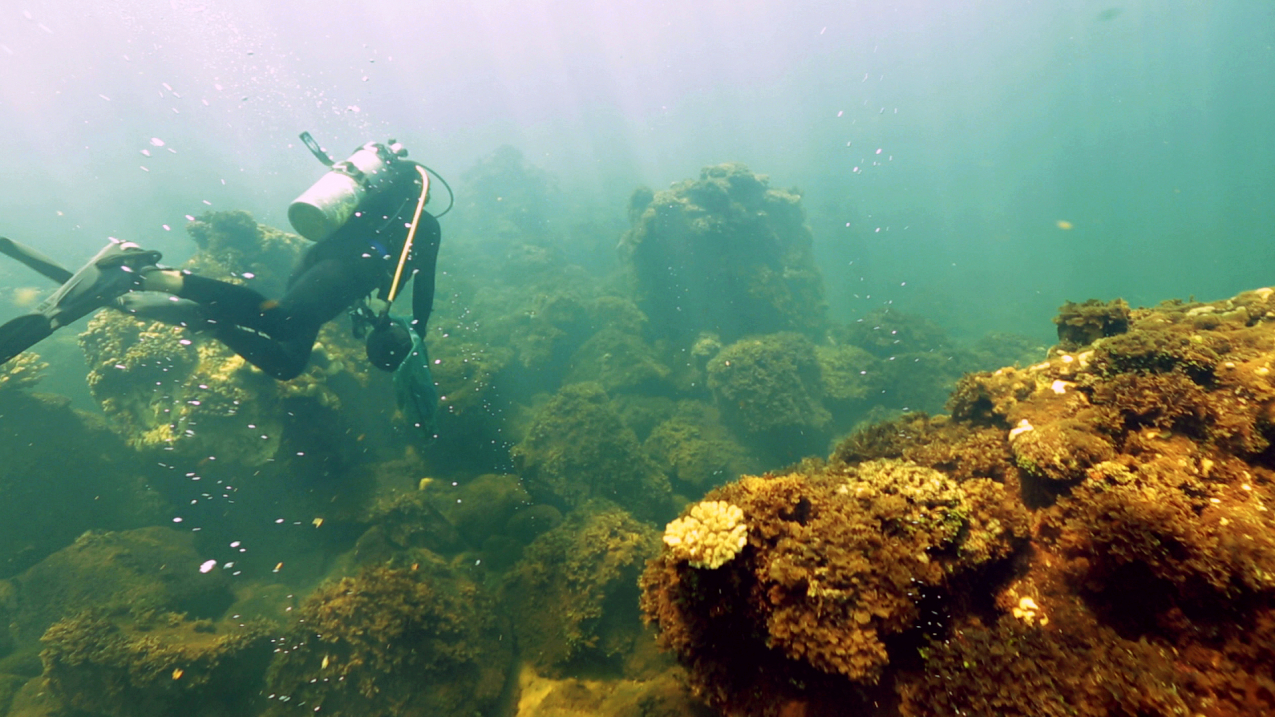
NOAA researcher Ian Enochs dives over underwater vents near an uninhabited volcanic island north of Guam. Given its remoteness, the island offers a unique natural laboratory to study how ocean acidification affects coral reef ecosystems. (Image credit: NOAA)
Ocean acidification: A wake-up call in our waters
In a high carbon dioxide world, dangerous waters ahead
Window on our future
Tackling the challenges
For good reason, ocean acidification is often called “climate change’s evil twin.” The overload of carbon dioxide (CO2) in our ocean is literally causing a sea change, threatening fragile, finite marine life and, in turn, food security, livelihoods and local to global economies.
Like a sponge, our ocean are absorbing increasing amounts of CO2 from the atmosphere. Over the past 200 years, the world’s seas have absorbed more than 150 billion metric tons of carbon from human activities. Currently, that’s a worldwide average of 15 pounds per person a week, enough to fill a coal train long enough to encircle the equator 13 times every year. CO₂ concentrations are now higher than at any time during the past 800,000 years, and the current rate of increase is likely unprecedented in history.
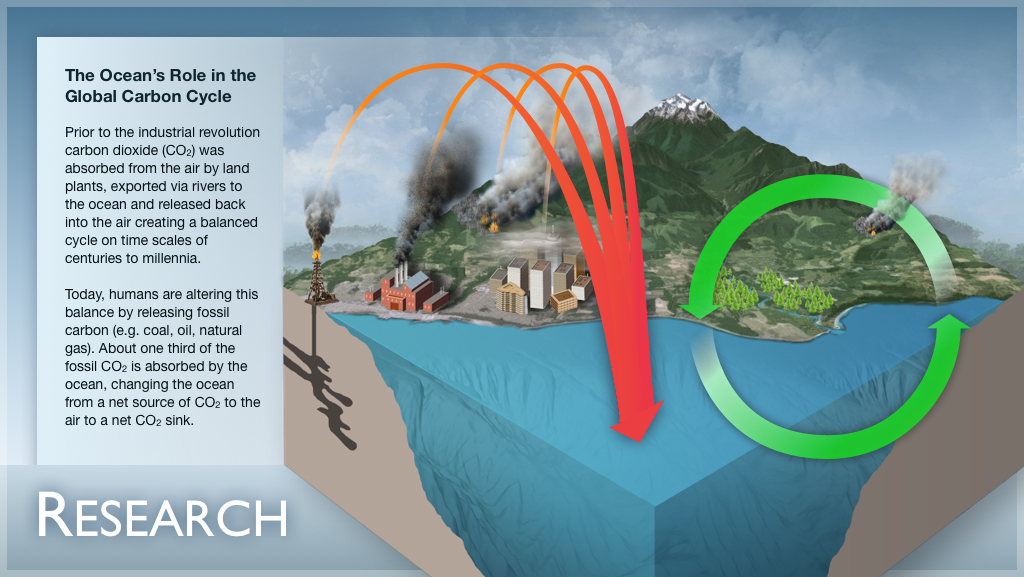
The consequences of disrupting what has been a relatively stable ocean environment for tens of millions of years are beginning to show. The massive amount of carbon dioxide being absorbed by the ocean dissolves in seawater as carbonic acid. This process is known as ocean acidification, and it’s literally causing a sea change that is threatening the fundamental chemical balance of ocean and coastal waters from pole to pole. Increasingly, corrosive waters are making it difficult for fragile marine life to build their protective shells and skeletons.
While much is still unknown about ocean acidification, science already shows that its consequences can be profound. Some of the two most vulnerable species are the small life forms that salmon and other commercially-important fish depend on for food. How these fish may adapt to an eroding food supply is a critical question. Along with increasingly acidified waters, the ocean is warming, and the oxygen critical to marine life is decreasing. Each stressor is a problem. But all three hitting our ocean at one time is a triple threat, with enormous implications for food security, local to global economies, jobs, and vital consumer goods and services.
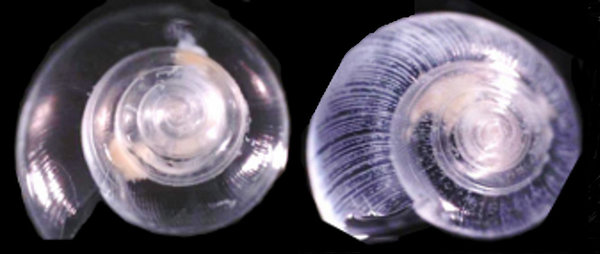
The first nationwide study of the vulnerability of the $1 billion U.S. shellfish industry and the coastal communities that depend on it revealed a daunting list of hotspots.
For good reason, ocean acidification is called “osteoporosis of the sea.” Ocean acidification can create conditions that eat away at the minerals that oysters, clams, lobsters, shrimp, coral reefs, some seaweed plants and other marine life use to build their shells and skeletons.
Human health, too, is a concern. In the laboratory, many harmful algal species produce more toxins and bloom faster in acidified waters. A similar response in the wild could harm people eating contaminated shellfish and sicken fish and marine mammals. And while ocean acidification won’t make seawater dangerous for swimming, it will upset the balance among the multitudes of microscopic life found in every drop of seawater. Such changes can affect seafood supplies and the ocean’s ability to store pollutants, including future carbon emissions.

In 2015, the first nationwide study showing the vulnerability of the $1 billion U.S. shellfish industry to ocean acidification revealed a number of hotspots: the Pacific Northwest, Long Island Sound, Narragansett Bay, Chesapeake Bay, the Gulf of Mexico, and areas off Maine and Massachusetts. Also at risk are Alaska’s fisheries, which account for nearly 60 percent of U.S. commercial fish catch and support more than 100,000 jobs.
Ocean acidification is weakening coral structures in the Caribbean and in cold-water reefs in waters off of Scotland and Norway. It is a concern in the Great Barrier Reef, where living corals have declined by half over the past three decades, reducing habitat for fish and the resilience of the entire reef system. Native fisheries in Patagonian waters may also be threatened. Dramatic change is apparent in the Antarctic, where the frigid waters can hold so much CO2 that shelled creatures dissolve in the corrosive conditions, affecting food sources for fish, birds and marine mammals.
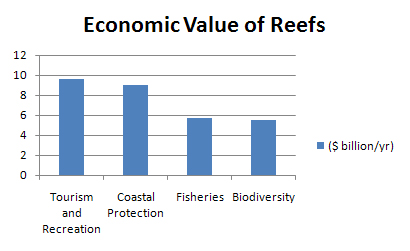
Smart investments in monitoring and observing are critical to hedging the risks. We can‘t manage what we don’t measure, and observations are requisite to providing the environmental intelligence that underpins sound approaches to countering acidification.
There is urgency to making such investments. NOAA’s around-the-clock monitoring of global atmospheric CO2 indicates the rate of increase has never been higher than during the past three years, accelerating the ocean acidification process.
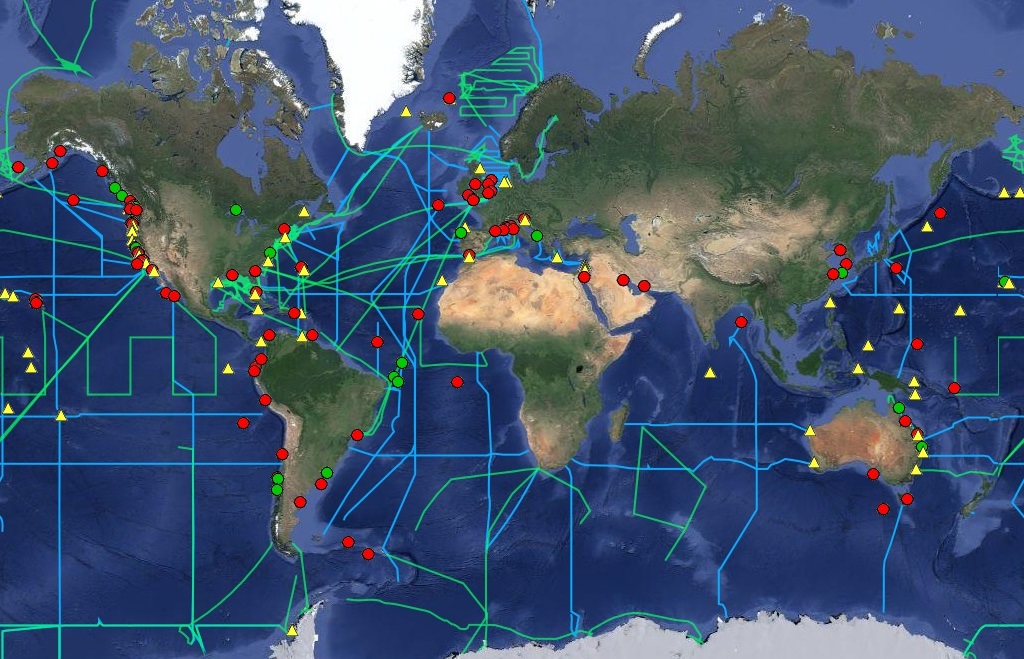
This is why, in the most ambitious step ever taken by the US to address climate change, President Obama has called for 1,000 US power plants to reduce emissions by 32 percent by 2030, as compared with 2005 levels. This reduction equals the annual output of 150 million cars, or two-thirds of all US passenger vehicles.
To forecast ocean and coastal conditions and understand implications all along the food chain, observations are essential. In the mid-2000s, ocean acidification nearly collapsed the $117 million West Coast shellfish industry until coastal monitoring strengthened by the fuller offshore picture provided by the NOAA Ocean Acidification Program and the real-time data of U.S. Integrated Ocean Observing System® buoys provided an early warning system. Signaling the approach of acidified seawater enables hatchery managers to schedule production when water quality is right. In 2014, a NOAA-led study showed that acidified water was emerging off the coasts of Alaska’s already most vulnerable communities, allowing scientific insight to be factored into adaptive and mitigation strategies. In Maine, a broad coalition is considering monitoring local drivers such as industrial, agricultural and urban run-off to understand how they might be adding to the problem.
To prevent ocean acidification from being a game-changer, robust forecasting capabilities and public/private partnerships are needed to interpret not only the global picture but regional and community conditions. For this reason, NOAA co-leads the pioneering 30-nation Global Ocean Acidification Observing Network designed to monitor the progression of acidification and identify those areas of highest risk.
For good reason, ocean acidification is often called “climate change’s evil twin.” The overload of carbon dioxide (CO2) in our ocean is literally causing a sea change, threatening fragile, finite marine life and, in turn, food security, livelihoods and local to global economies.
Like a sponge, our ocean are absorbing increasing amounts of CO2 from the atmosphere. Over the past 200 years, the world’s seas have absorbed more than 150 billion metric tons of carbon from human activities. Currently, that’s a worldwide average of 15 pounds per person a week, enough to fill a coal train long enough to encircle the equator 13 times every year. CO₂ concentrations are now higher than at any time during the past 800,000 years, and the current rate of increase is likely unprecedented in history.

The consequences of disrupting what has been a relatively stable ocean environment for tens of millions of years are beginning to show. The massive amount of carbon dioxide being absorbed by the ocean dissolves in seawater as carbonic acid. This process is known as ocean acidification, and it’s literally causing a sea change that is threatening the fundamental chemical balance of ocean and coastal waters from pole to pole. Increasingly, corrosive waters are making it difficult for fragile marine life to build their protective shells and skeletons.
While much is still unknown about ocean acidification, science already shows that its consequences can be profound. Some of the two most vulnerable species are the small life forms that salmon and other commercially-important fish depend on for food. How these fish may adapt to an eroding food supply is a critical question. Along with increasingly acidified waters, the ocean is warming, and the oxygen critical to marine life is decreasing. Each stressor is a problem. But all three hitting our ocean at one time is a triple threat, with enormous implications for food security, local to global economies, jobs, and vital consumer goods and services.

The first nationwide study of the vulnerability of the $1 billion U.S. shellfish industry and the coastal communities that depend on it revealed a daunting list of hotspots.
For good reason, ocean acidification is called “osteoporosis of the sea.” Ocean acidification can create conditions that eat away at the minerals that oysters, clams, lobsters, shrimp, coral reefs, some seaweed plants and other marine life use to build their shells and skeletons.
Human health, too, is a concern. In the laboratory, many harmful algal species produce more toxins and bloom faster in acidified waters. A similar response in the wild could harm people eating contaminated shellfish and sicken fish and marine mammals. And while ocean acidification won’t make seawater dangerous for swimming, it will upset the balance among the multitudes of microscopic life found in every drop of seawater. Such changes can affect seafood supplies and the ocean’s ability to store pollutants, including future carbon emissions.

In 2015, the first nationwide study showing the vulnerability of the $1 billion U.S. shellfish industry to ocean acidification revealed a number of hotspots: the Pacific Northwest, Long Island Sound, Narragansett Bay, Chesapeake Bay, the Gulf of Mexico, and areas off Maine and Massachusetts. Also at risk are Alaska’s fisheries, which account for nearly 60 percent of U.S. commercial fish catch and support more than 100,000 jobs.
Ocean acidification is weakening coral structures in the Caribbean and in cold-water reefs in waters off of Scotland and Norway. It is a concern in the Great Barrier Reef, where living corals have declined by half over the past three decades, reducing habitat for fish and the resilience of the entire reef system. Native fisheries in Patagonian waters may also be threatened. Dramatic change is apparent in the Antarctic, where the frigid waters can hold so much CO2 that shelled creatures dissolve in the corrosive conditions, affecting food sources for fish, birds and marine mammals.

Smart investments in monitoring and observing are critical to hedging the risks. We can‘t manage what we don’t measure, and observations are requisite to providing the environmental intelligence that underpins sound approaches to countering acidification.
There is urgency to making such investments. NOAA’s around-the-clock monitoring of global atmospheric CO2 indicates the rate of increase has never been higher than during the past three years, accelerating the ocean acidification process.

This is why, in the most ambitious step ever taken by the US to address climate change, President Obama has called for 1,000 US power plants to reduce emissions by 32 percent by 2030, as compared with 2005 levels. This reduction equals the annual output of 150 million cars, or two-thirds of all US passenger vehicles.
To forecast ocean and coastal conditions and understand implications all along the food chain, observations are essential. In the mid-2000s, ocean acidification nearly collapsed the $117 million West Coast shellfish industry until coastal monitoring strengthened by the fuller offshore picture provided by the NOAA Ocean Acidification Program and the real-time data of U.S. Integrated Ocean Observing System® buoys provided an early warning system. Signaling the approach of acidified seawater enables hatchery managers to schedule production when water quality is right. In 2014, a NOAA-led study showed that acidified water was emerging off the coasts of Alaska’s already most vulnerable communities, allowing scientific insight to be factored into adaptive and mitigation strategies. In Maine, a broad coalition is considering monitoring local drivers such as industrial, agricultural and urban run-off to understand how they might be adding to the problem.
To prevent ocean acidification from being a game-changer, robust forecasting capabilities and public/private partnerships are needed to interpret not only the global picture but regional and community conditions. For this reason, NOAA co-leads the pioneering 30-nation Global Ocean Acidification Observing Network designed to monitor the progression of acidification and identify those areas of highest risk.


